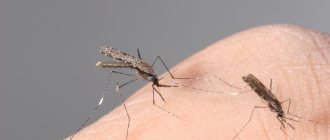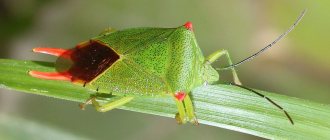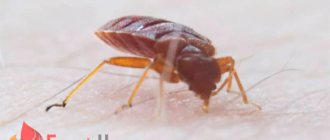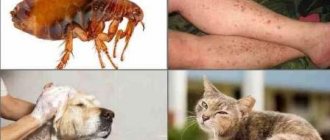Bedbugs are ectoparasites that feed on human blood, so their appearance in a house brings serious discomfort to all its inhabitants. It would also be useful to know how bedbugs and pets coexist, since ectoparasites can possibly ruin their lives.
To know this for sure, you need to study the characteristics of parasites and their feeding preferences.
Do bedbugs bite pets?
Bed bugs can bite pets, but they do this very rarely, only in cases where they cannot bite people indoors . If people regularly spend the night in an apartment and a cat or dog lives right there, then bedbugs here will not bite animals, they will bite people. They have a certain selectivity - people are more attractive to them because they emit more odor and emit more infrared radiation than a pet.
Plus, as a rule, bedbugs can get to people faster, especially if they hide in sleeping areas.
In addition, animals are less preferred by bedbugs due to their thicker, longer fur and tougher skin. To bite a cat or dog, a bug with its wide body needs to somehow get through dense thickets of fur, which is difficult for it. Just compare the body shape of a bug and a flea. The first specializes in parasitizing humans, the second bites primarily animals. The flea's body is narrow and tall, adapted for maneuvering among hairs. But for the bug it is flat, suitable for hiding in narrow crevices near human resting places, but not convenient for moving in thick fur.
As a result, bedbugs prefer not to attack animals if they can bite people. That is, if you regularly spend the night in an apartment and are bitten by bedbugs, then they will not touch the animals. Even if individual parasites attack a cat or dog, their bites on animals will be rare and few in number. They will not bite your pet directly.
What if they do chew?
It happens that owners find their pets literally covered with insects from head to toe. Or they notice that the animal is itching furiously. In this case, bedbugs have nothing to do with it - ticks or fleas are to blame.
- Ticks are very similar in appearance and size to bed bugs, so they are often confused. To prevent insidious insects from misleading you, you need to remember that ticks have eight legs, unlike the six of bedbugs. In addition, if a tick sticks to the skin, it cannot move and resembles a mole.
To remove a tick from a cat, there are special tools that can be purchased at veterinary clinics or pet stores. If they are not there, then regular tweezers will do. You need to grab the tick as close to the head as possible and smoothly pull it out of the wound. You should not smear the tick with various kinds of substances in order to drive it out - the parasite will not go away, but it will release much more bacteria and toxins into the wound. But after the tick is removed, the wound should be lubricated with alcohol.
- Some people manage to confuse bed bugs with fleas. It is very easy to distinguish them - fleas are jumping and nimble, and their size is much smaller than that of mattress bloodsuckers.
Do bedbugs cause diseases in cats and dogs?
- Bed bugs do not transmit diseases through blood. At least not a single case has been identified so far, so bedbugs will not infect a cat or dog with hepatitis or rabies.
- Bedbug bites cause irritation and itching on the skin. If an animal scratches bites, there is a risk of skin infection entering the wound. In this situation, contact your veterinarian to relieve the itching and prevent infection from developing.
- If a cat or dog eats a poisoned bedbug, the consequences will depend on the insecticide used. Low-hazard drugs of the 3rd and 4th classes in the dose contained in one eaten bug do not pose a serious threat to cats and dogs. However, when treating the premises, diligently follow the safety measures described in the instructions for the insecticide to avoid poisoning.
Destroy, cannot be pardoned
First of all, the injured animal requires treatment. A bitten cat is bathed with a special product and the fur is thoroughly combed to relieve itching and irritation. While the premises are being treated, the pet is removed from the premises so that it does not ingest the poison.
The animal's bedding is washed in hot water and then dried with a stream of heated air. If the rug cannot be washed, then thoroughly clean it and blow it with a hot hairdryer. The sleeping area is vacuumed, walking along the walls and baseboards, and treated with a special composition against parasites.
Bedbugs rarely give up ground without a fight, so it is not easy to destroy them. It is advisable to entrust the fight against uninvited guests to professionals who know exactly how to completely get rid of parasites.
Cats and dogs are rarely targeted by bedbugs. Usually bloodsuckers simply live next to a warm animal, hiding in its bedding. But hungry bugs do not hesitate to feast on the blood of pets when humans are out of their reach. At the slightest suspicion of the presence of bedbugs in the house, urgent measures are taken to destroy them.
How to remove bedbugs from a cat or dog
It takes very little for your home to become infested with bed bugs. They thrive in hard-to-reach places, making them difficult to eradicate.
As a rule, the best results are achieved when the destruction is carried out by a specialist. The first step is to determine where the bed bugs are. The bedroom is their most common habitat. Bed bugs are also common in living rooms. Infestations can start in one room and move to others over time.
Seventy percent of infestations are located around beds, so much of the eradication process is aimed at clearing these areas.
Bed linens are washed in hot water, mattresses are encased in insect-proof covers, and bed frames are treated with both a vacuum cleaner to remove large adults and nymphs and chemicals to kill eggs.
If bed bugs are found in other areas, such as dressers, the same process is repeated there.
There are many different products available to eliminate bed bugs. It is very important to read both the label and the safety data sheet of the product for little brothers. None of the products should be applied directly to the pets themselves.
Can bedbugs bite cats and dogs?
Bed bugs can bite people or pets, or even wild animals that sneak into abandoned homes (though this is not as common for obvious reasons). This is why bed bug infestations in uninhabited homes can continue for so long, even though no one is around.
The only problem is that bed bugs don't like fur or hair. It's much harder for them to bite your pet than it is for them to bite you.
Do cats and dogs attract bed bugs?
Bed bugs are attracted to two main lures: body heat and carbon dioxide. By following them, bloodsuckers can easily find their way to the owner. Humans, cats, dogs of any breed, and other pets are warm-blooded and breathe, so bed bugs can find your furries just as easily as they can find you.
However, cats and dogs cannot attract bed bugs unless there is already an infestation nearby. A bedbug infestation doesn't just come out of nowhere. Bed bugs can usually find a new host within six feet, but they may explore around in an attempt to find someone.
So if your neighbor has bed bugs, a cat can help lure them away. But if no one around has bed bugs, there's no way to attract them.
Where do bedbugs bite cats and dogs?
Bed bugs prefer to bite areas that don't have a lot of fur or hair. That's why when you wake up with bed bug bites, they're more likely to be on your back or legs than on your head.
When it comes to biting pets, bed bugs will choose areas where they have easier access to the skin. They cannot dig into the fur, they will choose more open areas such as:
- Stomach
- Ears
- Parts of their feet
Check your cat or dog to see where they have less fur and if they have bites there if you think they have suffered from bed bugs. Cats and dogs with thicker or longer fur are at lower risk because there is less room for bed bugs to bite. To be sure that the poor animal has suffered from bedbugs, look at what bites look like on the Internet.
conclusions
But when it comes to bed bug control, you may want to ignore the existence of some insects for a while. They cannot kill all bed bugs and solve the problem for you, but they can help you.
There are probably other creatures that also eat bed bugs, but you're unlikely to find one that you can use without suffering the negative traits of a predator, or that can catch and eat enough bed bugs to effectively neutralize your infestation.
Among the representatives of the fauna, there is no universal remedy for those who drink your blood at night.
What animals can be bitten by bedbugs?
Even despite the serious protection of pets, in the form of a repulsive odor, thick skin and thick fur, they can also suffer from an invasion of arthropods. Let's figure out who the parasites choose if human blood is not available.
Birds
Poultry are the only “creatures” that suffer from bedbug bites as much as humans. Those who have cut up a chicken carcass at least once in their life know that the skin of hens and chickens is delicate and very thin, and it is very easy to pierce it with a proboscis.
The concept of “chicken bug” does not exist in nature; Birds are bitten by common bed bugs. It is quite rare for insects to settle in a chicken coop, but if this happens, treatment must be carried out immediately. The fact is that parasites spread very quickly and almost instantly infect all birds. Concerned animals begin to pluck feathers on the affected areas of the skin, quickly lose weight and stop laying eggs. There have been cases where bloodsuckers caused the mass death of chickens.
If the bugs get to the hens, there is a risk that the birds will leave their clutches just to get rid of the insects as quickly as possible. Therefore, if you notice symptoms of infection, immediately rescue chickens and other pets.
Bedbugs settle in chicken coops in the following places:
- between bird cages
- in the cracks and gaps of the walls,
- in nests and perches,
- all not,
- on the floor, under a layer of droppings.
On a note! In addition to chickens, arthropods bite canaries, guinea fowl, parrots and other feathered pets. The only exceptions are waterfowl - ducks, geese - bedbugs are unable to bite through their dense skin.
As soon as bed bugs are noticed in a cage or chicken coop, we immediately move the birds to safe places and begin treating their “living area.” The “expulsion” of parasites is carried out by Chlorophos or Karbofos. Strictly follow the instructions included in the instructions so as not to overdo it with the concentration of chemicals.
As soon as the processing is completed, we remove all garbage and droppings from the cages and chicken coops, wash the perches, and clean the walls. The procedure should be repeated after 10-12 days.
On a note! If your region has very cold winters, newly hatched bedbugs can be removed by simply freezing out the chicken coop. The fact is that parasites die at temperatures below -10 degrees Celsius, so you don’t have to resort to chemicals. The main thing is not to let the chickens catch a cold, but rather move them to another room for a while.
Dogs and cats
Bedbugs bite dogs and cats only in exceptional cases: when it is impossible to get close to “softer-skinned” prey. For example, you decided to go on vacation for a couple of weeks, and left the care of the animals to your friends and neighbors. Arthropods that are active only at night will not be able to feast on the neighbor’s blood, so they will be forced to hunt for “woolly” pets.
Parasites are wary of “wool labyrinths,” but hairless purebred cats do not have this feature, which means it will not be difficult for bedbugs to get to their skin. So, if your Sphynx has developed strange red blisters overnight and is constantly itching, it's time to treat your living area.
On a note! Bed bugs can live in pet beds and rugs, so pay special attention to them during treatment.
When symptoms of bites appear, the first step is to bathe the affected animal with a special shampoo, and then comb its fur well to relieve itching and irritation from the affected areas.
Not only bedbugs, but also other parasites can bother your four-legged friends. For example, ticks. It is not difficult to distinguish them: although ticks are similar to bedbugs in size and color, they differ in the number of legs (bugs have 6, ticks have 6, and ticks have a “lifestyle” (ticks are active at any time of the day). Therefore, if you notice during the day there are black spots on the fur, which means that the pet has become the “chosen one" of ticks. By the way, when detected, the parasite will remain motionless, while the domestic bug will try to instantly elude watchful eyes.
For example, ticks. It is not difficult to distinguish them: although ticks are similar to bedbugs in size and color, they differ in the number of legs (bugs have 6, ticks have 6, and ticks have a “lifestyle” (ticks are active at any time of the day). Therefore, if you notice during the day there are black spots on the fur, which means that the pet has become the “chosen one" of ticks. By the way, when detected, the parasite will remain motionless, while the domestic bug will try to instantly elude watchful eyes.
It must be borne in mind that bedbugs prioritize human blood rather than animal blood. Therefore, if parasites take a desperate step and bite cats and dogs, it means that the living space is filled to capacity with them.
We recommend viewing
Do cats mate with their siblings? Do cats miss their owners when they are returned home? Black Cats
Smelly discharge can also irritate your cat's mouth and stomach. They will immediately feel the effects of the liquid as soon as it touches their mouth, tongue and lips.
Although some cats will try to eat the copperhead, these secretions will likely cause the animal to abandon it and give up the hunt.
If infected, your cat's symptoms should resolve on their own within 8-12 hours without treatment. However, owners should monitor them for deteriorating health.
Bezoars
In many cases, the scutellum, the stink bug's hard outer shell, is not digested. If a cat eats a significant amount of bedbugs, a bezoar will form in its body. This is a formation in the gastrointestinal tract caused by a foreign body.
Some are ejected naturally, but because the beetles' shells are so hard, most get stuck in the stomach, forming a hard, round mass. If the bezoar is too large, it can only be removed surgically. Signs of a bezoar include:
- Loss of appetite
- Weakness
- Lethargy
- Diarrhea
- Watery vomit
- Anxiety
- Vocalization
- Abdominal pain
You may also notice a hard mass whenever you touch your cat's belly. However, you should avoid touching too often, as this may cause pain or discomfort to the animal.
Eye damage
Because some species of copperheads can spray their chemicals several centimeters away, a cat's eyes are vulnerable. The discharge should not cause blindness or loss of vision, but it does cause a burning sensation. It may also cause short-term damage. Signs that your cat is suffering from eye pain include:
- teary eyes
- Stroking the eye with a paw
- Redness
- Discharge
- Inability to open the affected eye
If your cat gets stink bug fluid in her eye, rinse it with a saline solution and wipe it with a damp cloth to remove the discharge.
The eye should clear up on its own, but if it doesn't, take your cat to the vet. You may need antibiotic drops or something similar to deal with the irritation.
Likewise, swollen eyes are a sign of infection or severe irritation and require veterinary attention.
Pesticides
Scale insects are considered agricultural pests. They damage crops and feed on fruit, causing a nuisance to farm owners who are forced to use pesticides to repel cottonmouths.
As a result, there is a serious risk that by eating cottonmouths, your cat could ingest harmful chemicals that could make her sick. Poisoned cats exhibit the following symptoms:
- Tremor
- twitching
- Abdominal pain
- Dilated pupils
- Excessive drooling
- Convulsions
- Severe vomiting
- Inconsistency and instability
- Labored breathing
- Lethargy
- Loss of appetite
In case of pesticide poisoning, cats should be taken to a veterinarian immediately for treatment. If left untreated, cats will develop long-term damage.
What do bites look like?
Owners should know what dog bug bites look like. Animals cannot complain or point out what is bothering them.
You can suspect that your pet faces an attack of blood-sucking parasites every day based on the following signs:
- During a bite, the pest secretes a special secretion that blocks the sensitivity of the nerve endings and prevents the blood from quickly clotting, so neither the person nor the animal feels the moment of the puncture. But after some time they begin to experience burning, itching, and discomfort.
- The pet begins to behave restlessly and is constantly itching. Bald spots appear at the site of the bite.
- Upon careful examination of the animal's body, it is possible to detect bites under the fur in the form of a path of 5 or more red dots located nearby.
The bite causes severe allergies or causes inflammation, since blood-sucking insects carry pathogenic microorganisms (viruses, bacteria).
Rodents
Various types of rodents are quite vulnerable to bedbug bites - hamsters, rats, guinea pigs and chinchillas. It is this category of animals that is considered the main source of food for parasites in nature. “Wild” bedbugs love to live in warm rodent burrows and bite them in places not covered by fur. A sign that bloodsuckers are attacking your pet are red spots and bald spots on the skin - the animal will scratch the bite site and pull out the fur.
Are bites dangerous?
A bedbug can carry very dangerous diseases - anthrax, tuberculosis, typhoid, hepatitis and other equally serious ailments. However, infection occurs very rarely - like any parasite, the bug tries to keep its victims healthy, so it does not infect them with dangerous diseases. And although scientists have indeed proven that a bite can cause the transmission of a number of viruses and bacteria, such cases are more typical in laboratory conditions.
However, this does not mean that you can relax - bedbug bites can cause severe allergies not only in people, but also in cats. Usually, purebred cats are affected, which are often characterized by weakened immunity and a tendency to allergic reactions.
Power Mechanism
Regardless of the habitat of bed bugs, all these representatives have a piercing-sucking type, a well-developed oral apparatus, with the help of which they suck in liquid matter. The jaws are presented in the form of a proboscis, with stilettos inside. They act like scissors. When extending, the stilettos simply pierce the body intended for nutrition. There are also 2 channels in the trunk. One of them serves to absorb food, the other - to inject the secretion of the salivary glands, containing a large amount of active substances:
- similar to anesthetics, they relieve pain during a bite;
- enzymes that digest proteins;
- toxic substances of a neuroparalytic nature;
- toxic components that can kill prey with saliva (typical of predators).
Can a pet bring an insect into the house?
Bedbugs and Pets
A person who keeps a pet, especially those species that walk outside, is often concerned whether the cat can bring bedbugs into the house. To answer this question, you should remember the ways bedbugs get into the room:
- an infected neighboring apartment - bloodsuckers will move through the ventilation system and other cracks;
- they arrive with purchased old furniture;
- are brought into the house with the owner’s belongings after staying in public hotels, state clinics and other institutions where sanitation suffers.
The bug is nocturnal and mostly sleeps during the day, so the chances of an animal bringing the parasite into the house are negligible.
The following facts confirm that a cat or dog cannot bring bedbugs:
- The host body is only a temporary location for the bedbug during the feeding period. After a series of bites, the well-fed individual returns to the nest to sleep.
- The parasite may use a cat or other animal as a means of transportation, giving it the ability to migrate from one room to another in search of food. A well-developed sense of smell helps an insect smell blood.
- A cat, dog and other animal cannot become a habitat for a bedbug due to the fact that the bloodsucker prefers to settle as close as possible to human sleeping places. From there it is easier and faster to get to the food facility. The opinion that bloodsuckers live on cats or dogs is wrong.
Important!
If a bug is found in the apartment, you should not let your pet into this room, then it will not be able to carry the pest, which will become an obstacle to its spread.
The insect does not live in grass, trees, or other outdoor vegetation. The only possible option for an animal to bring a bedbug into an apartment is if it often walks through basements or visits a house where there are already bloodsuckers. In this case, the bug will be able to cling to the dog’s fur and move to another apartment.
A little history
The first blood-sucking bugs were content with the blood of rodents. They lived in the wild, so mouse holes served as their home. But with the advent of man, everything changed: thin and smooth human skin turned out to be much more seductive. Since then, bed bugs have inextricably linked their lives with humanity.
Where do parasites come from? They come from distant countries in suitcases, run away from unscrupulous neighbors, and hide in the folds of clothes when visiting guests. Often insects enter an apartment along with new furniture or household appliances. Bugs are very inventive in conquering new territories.
Tips for removing bedbugs
Methods for controlling bedbugs
When traces of the presence of bedbugs are obvious, a person should immediately take measures to combat parasites:
- Fight with folk methods. Safe for animals, but low removal efficiency.
- The use of chemicals is a rational option that requires special care.
- Calling special services to exterminate bedbugs.
Fighting parasites with folk remedies is completely safe for humans and their pets, so no additional measures will have to be taken.
The use of an insecticide to get rid of bedbugs if there is a cat, dog or other pet in the house must be carried out in compliance with the following rules:
- At the time of treatment, be sure to remove the pet from the premises.
- Carefully treat the animal's sleeping area.
- Touch all the places where the animal prefers to spend time: rugs, boxes, baskets.
What else should you know?
People usually notice secondary signs of a bedbug infestation before they discover the live parasite itself.
If you notice translucent exoskeletons, black stains of insect droppings, or red blood stains on the sheets around the house, there is no need to look for bite marks. Start fighting insects.
Live beetles range in color from rusty to bright red depending on how long ago they fed. They can hide in bed frames, box springs, papers on the floor, curtain rods, even small folds of wallpaper that have come off the wall. There is a known case where bed bugs were even located in a person’s prosthetic leg!
Prevention
To prevent the bug from getting to the animal, simple prevention will help:
- Vacuum your cat and dog rug regularly.
- It is recommended to wash your pet's bedding 2 times a month.
- If possible, steam the laundry after washing.
- Periodically inspect not only the place where the dog or cat lives, but also the most favorite habitats of bedbugs: mattresses, sofas, baseboards.
Bed bugs can actually bite your pet. This will only happen in exceptional situations when there is no person nearby. In all other cases, the insect will prefer human blood.
Treatment of chemipterosis
The presence of bedbugs in an apartment always suggests that the cat's sleeping place may be infected.
You need to thoroughly clean the house and also make sure that all traces of insects are removed. Required:
- Vacuum cleaning (including mattresses);
- steam cleaning of cracks;
- washing and drying bedding, clothing and other items.
Since this is an important undertaking, you should call a professional to ensure complete pest control. There's nothing worse than having the little critters come back after you've spent the day trying to get them out!
Let's sum it up
Having answered the question “do bedbugs bite pets?”, I would like to emphasize once again that parasites can cause serious inconvenience to pets. Therefore, as soon as you suspect that there are uninvited guests in the apartment, immediately proceed to serious action.
Many owners believe that insects are only interested in human blood, so they deliberately leave residential buildings with the hope that the bugs will “leave” hungry. Nothing like this. Bed bugs will either bite domestic animals or wait for the return of the main “food items”. Therefore, do not waste your time and take care of your four-legged friends - they cannot fend for themselves!
Sources
- https://dezincity.ru/klop/o-klopah/kusajut-li-postelnye-klopy-domashnih-zhivotnyh
- https://klopy.geradez.ru/kusayut-li-klopy-koshek-ru
- https://KlopVred.ru/klopy/kusayut-li-postelnye-klopy-koshek-i-sobak/
- https://GdeKlop.ru/klopy/kusayut-li-klopy-domashnih-zhivotnyh/
- https://parazitdoma.ru/klopy/kusayut-li-klopy-domashnih-zhivotnyh
- https://netzhukam.ru/klopy/ukusy-klopov/kusayut-li-klopy-koshek.html
- https://notklop.ru/klopy/o-klopah/klopy-i-domashnie-zhivotnye/
[collapse]











